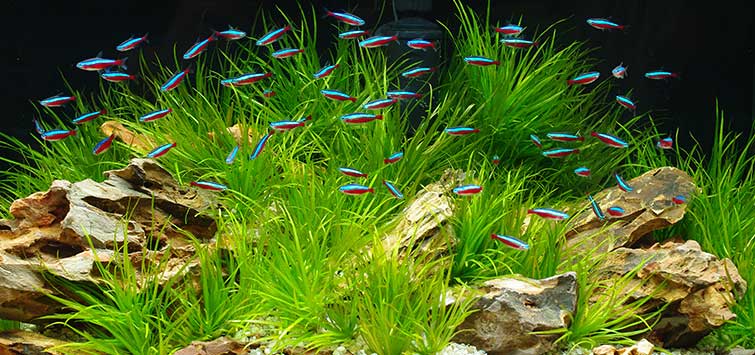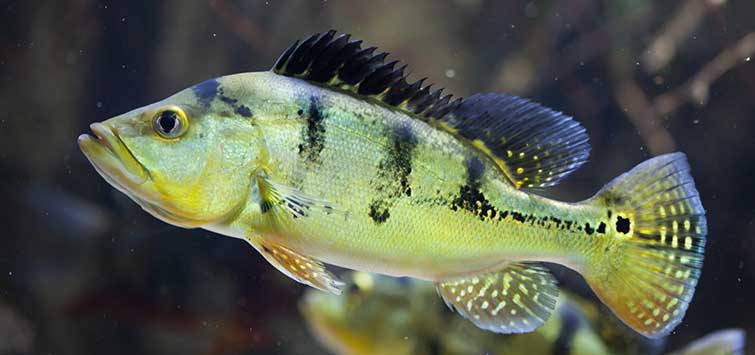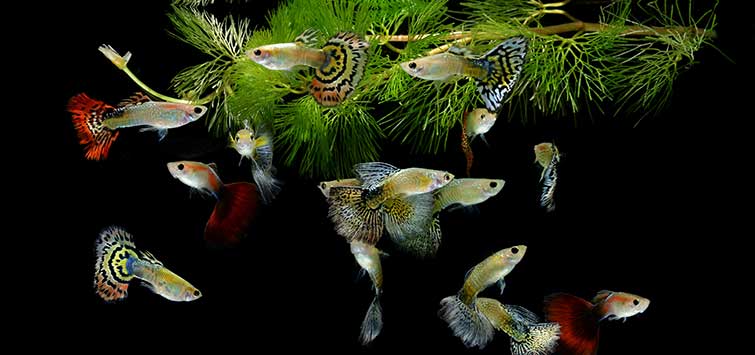Beyond the Community: Species-Only and Colony Tanks
Author: Bill Allen
Many new hobbyists (as well as veterans) like to incorporate different types of fish into a community tank; a lifelong aquarist explains the unique benefits of resisting that instinct and creating single-species setups that permit you to raise multiple generations of one species in a colony tank.
A Classic Scenario
"I want one of those zebra fish, one of those swordtail things, a spiny eel (aren’t they cool?), a fighting fish, a neon tetra, a sucker fish, and a tiger barb. Oh, and some kind of catfish so I don’t have to clean out the tank. Will that be okay for my new 10-gallon tank?”
How many times have you heard a conversation like this in a fish store? When I started keeping fish, I only wanted to get as many different and unusual fish as I could into my aquarium. That meant trying to get one—only one—of everything I saw in the store, or in TFH! And there were certainly a lot of fascinating fish to choose from.
Why Own a Single-Species Aquarium?
However, there is a place for an aquarium containing a single species only. Boring, you say? Not at all! When I was a young teenage aquarist, my mentor was a fellow named Bob Kintzing, whose specialty was guppies. I remember seeing several 55-gallon tanks in his fishroom, each completely filled with identical gorgeous blue delta tail guppies. Not only was it a beautiful display, but Bob was convinced that it was a true test of a breeder’s mettle to raise a strain of guppies in which every male was not only beautiful but also identical to his brother. A few years ago, the gift shop of the Memphis Zoo displayed a large aquarium completely filled with over a hundred large tiger barbs. Tiger barbs are pretty mundane fish, but watching that huge school move together as one entity was more fascinating than any reef display.
Freedom to Fine-Tune the Environment
There are also many other reasons to raise fish in a single-species-only setting. The best reason is that the environment can be fine-tuned to a particular fish’s liking. Black mollies, for example, look beautiful when placed with angelfish, but the mollies’ preference for hard, basic water is completely at odds with the angelfish’s liking of soft, acidic water. If you were to adjust your water conditions somewhere in the middle, neither fish will be very happy.
Observe Natural Social Behavior
Another reason for a single-species tank is the chance to see a fish’s social behavior. So many people get a single Corydoras catfish as the “janitor” of their aquarium. He mopes around the bottom, hardly moving, except to mouth the occasional piece of gravel. But put a small school—at least five—Corydoras in a tank and watch them. They’re as playful as a litter of puppies, tumbling over each other and taking turns playing follow-the-leader.
I once had a colony of hump-backed Limia nigrofasciata. Among the members were three virtually identically sized males that spent most of their time displaying and chasing each other. They would actually position themselves nose-to-tail in the front and center of the tank and chase each other in circles. But in spite of these ferocious battles, I never saw a single nipped fin or other sign of injury.
Single-Species Colonization
A species-only tank becomes a colony when the fish spawn and young of various broods and different sizes come together. In an ideal environment with plenty of food for the adults, cover for the babies, and small food for the youngsters, many young will escape being eaten, grow up, and begin raising their own families. In the finest Darwinian tradition, the strongest will survive, and the weaker ones won’t make it. As hard-hearted as it seems, this provides the aquarist with the better specimens without the need for tedious culling.
I once had a tank with some Poecilia chica (a small molly) and several Neolamprologus multifasciatus—a shell-dwelling cichlid, or “shellie,” from Lake Tanganyika. Both species of fish were doing reasonably well in their shared quarters, but I never saw any young from either species. But as soon as I gave them separate quarters, I had more shellies and chicas than I knew what to do with!
Colony Tank Requirements
A colony tank can be as small or large as required by the particular fish to be raised. I’ve raised several generations of Heterandria formosa in 2½-gallon tanks. I also had a nice colony of Neolamprologus brichardi in a 55-gallon tank. An extreme example of a colony tank can be seen at the Horseshoe Casino in Bossier City, Louisiana. This tank was designed, built, and is maintained by Randy Booth of Aquatic Specialties. This 3000-gallon tank contains several species of Lake Malawi cichlids. Several groups have staked out territory in various parts of the huge aquarium, and young of various sizes can be seen peeking out from the rock. Eventually, the youngsters mature and start their own families. However, the aquarium doesn’t have to be as huge as Horseshoe’s. The aquarium only needs to be large enough to accommodate the fish’s biological needs and social behavior, and the inevitable expansion caused by any additions. Most of my colonies are 10- or 15-gallon tanks, but fish that stay in one strata of the tank—top or bottom—may fare better in a 20-gallon-long tank. Fish that tend to stay in the middle of the tank may be more comfortable in a tall tank, such as a “show” tank measuring 25 gallons.
Tailoring Single-Species Conditions
Filtration, again, can be tailored to your fish. An undergravel filter is a good, easily maintained, unobtrusive filtration setup. But if your fish like to dig in the sand, as do shellies or other cichlids, an undergravel filter may not be a wise choice. In that case, sponge or outside filters may be better. Live plants are a good addition to most colony tanks. In addition to helping consume fish waste, they provide needed cover and sometimes food for the fry. Actually, the fry are not eating the plants themselves, but they are eating aufwuchs—the tiny flora and fauna that encrust various surfaces. All of my colony tanks have copious amounts of Java moss, as well as other plants. Another advantage to a colony tank is that food can be tailored to the specific fish, and you can be reasonably sure that food items won’t be snapped up by larger, more aggressive species before it reaches your target fish.
Best Colony Fish
There are a few guidelines to follow in acquiring good fish for a colony tank. They should be small enough not to quickly outgrow the tank, even with the inevitable additions. The fish should not be terribly territorial, but if they are, they should be small enough that the tank can provide plenty of different territories. They should also produce only small numbers of fry at a time, and they should not be voracious egg or fry eaters. This usually means fish that produce larger eggs or fry. The following are specific categories of good colony fish:
Livebearers
Almost every species of livebearer fits the bill as an ideal resident for a colony tank. They are small enough that a good number can be comfortably housed in a small or medium-sized aquarium. They propagate fairly easily with little attention from the hobbyist, and most parents will leave their youngsters alone if given plenty of food, and the fry are given plenty of plants for cover. Many of my friends in the American Livebearer Association keep colonies of endangered—and even extinct-in-the-wild—livebearers in colony tanks.
Especially of interest are the goodeids of Central Mexico. Many of these livebearers live in areas where their habitat is changing or being destroyed. Hobbyists keeping these fish in colony tanks may be the only hope of survival for some of these fish. Goodeids also have a preference for slightly cooler temperatures and like a cooling-off period during the winter in which their tank temperatures can go into the 60s. This is another reason for keeping goodeids in a colony situation—an unheated tank during the winter might be fatal for most tropical species, but it’s a great idea for many goodeids. I usually locate my goodeid tanks in cooler spots on the bottom rows in my fishroom.
Finally, goodeids generally produce small broods of unusually large fry. Broods of as few as six or seven are not unusual with younger female goodeids, and even a large female will seldom have broods that number into the dozens. Unlike most of the common livebearers that give birth every month or so, there is usually a 60-day gap between litters of goodeids. These fry are huge at birth.
Killifish
Of course, the so-called “annual” killifish are out of the question for a colony setup—their eggs must be collected, dried, stored, and then hatched. All this interference on the part of the aquarist violates the laissez faire ideal of fishkeeping we’re discussing here. However, not all killifish are annuals! Many will lay eggs in dense plants, and a few lucky youngsters will avoid getting eaten long enough to grow up and eventually become adult, reproducing members of the colony. I’ve heard of aquarists keeping Epiplatys species who didn’t even realize their fish were reproducing until they tore the tank down to move it and realized they had more fish than they started with!
Also, killies usually lay small numbers of eggs daily over an extended period of time. The result of this is a great disparity in the size and age of youngsters. Also, the eggs and fry of most killies are relatively large.
Labyrinth Fish
William T. Innes wrote in his famous book that a common technique used by commercial fishbreeders was to put two or three pairs of blue gouramis in a summer pond, throw in some water hyacinths, and at the end of summer the pond would be full of blue gouramis. This is sort of like a colony tank, but on a larger scale. I have, however, set up small tanks for several pairs of honey gouramis Trichogaster chuna, only to find out later that I had more fish in the tank than I started with.
Honey gouramis are wonderful and charming little fish, and they will bravely guard a nest, even in a colony tank. Also, their babies are larger and the broods are smaller than their close relatives, the dwarf gouramis, adding to their suitability for a colony tank. I have no experience with keeping some of the smaller exotic species of bettas,but I bet they would work well in a colony setup—particularly the mouthbrooders, with their large babies, small broods, and parental care.
Cichlids
Larger cichlids will do well in a colony situation, and their behavior is fascinating, but most cichlids are territorial and require lots of room. Unfortunately, a tank large enough to accommodate numerous pairs of large cichlids, like the one at the Horseshoe Casino, is out of reach for most of us, and many cichlids produce huge numbers of fry that make a colony situation a bit impractical. However, many smaller cichlids will dutifully raise a brood to adult size with no help from the aquarist, and these babies will grow up to parent other broods, which is what a colony tank is all about.
I mentioned “shellies” before. These small cichlids from Lake Tanganyika will set up housekeeping in snail shells scattered on the bottom of the tank. As the youngsters grow, they will stake out their own territory in the form of shells, until no shells are left and you have to rescue homeless fish for relocation elsewhere. Across the Atlantic Ocean in South America, the many species of Apistogramma and related dwarf cichlids will raise broods nearly until adulthood, and if there is enough room, the youngsters will begin to raise their own broods.
Fry
When you feed your colony, don’t forget the new arrivals! Babies hiding in the plants may snack on aufwuchs, but serious growth requires serious food. I hatch baby brine shrimp every day and sometimes keep microworms and other fry food on hand. It’s a good idea to feed adult food first before offering brine shrimp or other baby food. This way, the adults are satisfied and won’t hog all the food for the babies when it’s presented later. You can also use a baster to squirt the food near areas where the fry congregate.
But what about all that inbreeding? Aren’t you soon going to be raising a bunch of runted, sickly, deformed fish? Actually, if the fish are from good, genetically healthy stock, inbreeding is not a serious problem. The Xiphophorus Genetic Stock Center in San Marcos, Texas can give the pedigree of every fish in its 1200 tanks. They have some platies whose ancestors were brought in from Mexico by Dr. Myron Gordon in the 1930s, and for over 100 generations they have never been outcrossed. In fact, these fish are so closely related that tissue grafts can be performed on related fish and not rejected—the fish are almost clones of each other! But they are vibrant, healthy fish with no apparent genetic weakness. If you’re still concerned about inbreeding, you can keep two or more colonies of the same species going, and every few generations, swap a few members of each group with some of the others. Or you can find other aquarists raising the same fish and swap a few fish out every now and then.
How to Manage Rising Populations
Now you have a colony situation going, and your target species is happy and reproducing. But what are you going to do with all those fish? In the first place, your increases will not be huge. Commercial fish farmers do everything they can to save eggs and fry and to grow the fish quickly into sellable adults. But this isn’t the plan in a colony situation. Your first inclination may be to catch as many of the juveniles as you can and take them to your next fish club meeting, store, or online auction site, but this is not the best idea. Actually, the best thing to do is to remove your older, mature breeders and sell/trade them.
By removing the bigger fish, you are giving the remaining youngsters more room to grow. Remember that a fish that is twice as long is not just twice as much of a load on the filtration, it’s several times the load, because in addition to being longer, it’s deeper and broader. You also want your younger fish to reproduce so that not all the fish in the tank have the same parents. And, from a practical standpoint, bigger fish are generally worth more than smaller fish. You’ll get more for larger adults than younger juveniles. There are many outlets for the extra fish from your colony.
Finding the Right Connections
Some pet stores will buy, or take in trade, healthy fish from an aquarist they know. It’s very important that you build a good relationship with your local fish store if you expect them to buy some fish from you, and you should also do business with them for your other supplies. If you are a member of an aquarium society, your club certainly has auctions that you can participate in. If you’re not a member and there is a local club, you should consider joining. There are also specialist groups. I’ve mentioned the American Livebearer Association, but there are also national specialist groups for other types of fish. Most of them have some type of trading post for buying/selling/trading fish, but you have to be a member to participate. There are also online sites that auction fish and aquatic supplies.
So go ahead and try a colony tank—a tank with only one species of fish can be a very interesting place!
See the full article on TFH Digital http://www.tfhdigital.com/tfh/200902/#pg83

.png?h=595&iar=0&w=2781&hash=5FD5E69473BCC22199FBFA2FB71B6033)




